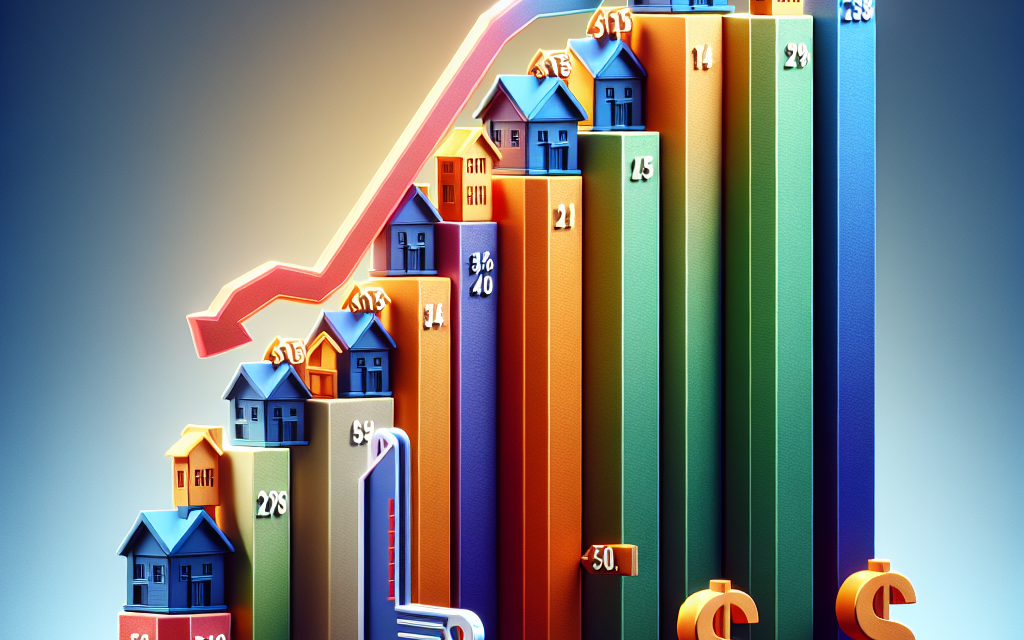“U.S. Mortgage Rates Surge to Highest Levels Since July: A New Era for Homebuyers.”
Introduction
U.S. mortgage rates have surged to their highest levels since July, reflecting a significant shift in the housing market and broader economic conditions. This increase is driven by various factors, including rising inflation, changes in Federal Reserve monetary policy, and heightened demand for housing. As prospective homebuyers face steeper borrowing costs, the implications for the real estate market and overall economic activity are becoming increasingly pronounced. This trend raises concerns about affordability and may influence buyer behavior in the coming months.
Current Trends in U.S. Mortgage Rates
In recent weeks, U.S. mortgage rates have surged to their highest levels since July, marking a significant shift in the housing market landscape. This upward trend has been influenced by a combination of economic factors, including inflationary pressures, Federal Reserve monetary policy, and broader market dynamics. As prospective homebuyers and current homeowners navigate this evolving environment, understanding the implications of rising mortgage rates becomes increasingly crucial.
The recent spike in mortgage rates can be attributed primarily to the Federal Reserve’s ongoing efforts to combat inflation. In response to persistent price increases across various sectors, the Fed has implemented a series of interest rate hikes aimed at stabilizing the economy. These adjustments have a direct impact on mortgage rates, as lenders often adjust their rates in anticipation of changes in the federal funds rate. Consequently, as the Fed signals its commitment to maintaining a tighter monetary policy, mortgage rates have followed suit, leading to increased borrowing costs for consumers.
Moreover, the current economic climate has contributed to heightened uncertainty, further influencing mortgage rates. Investors are closely monitoring economic indicators, such as employment figures and consumer spending, which can signal the overall health of the economy. When economic data suggests potential growth, investors may anticipate further rate increases, prompting them to adjust their expectations for mortgage rates accordingly. This interplay between economic indicators and investor sentiment creates a dynamic environment where mortgage rates can fluctuate significantly in a short period.
In addition to these macroeconomic factors, the housing market itself is experiencing notable changes. With rising mortgage rates, many potential homebuyers are finding themselves priced out of the market or reconsidering their purchasing decisions. This shift can lead to a slowdown in home sales, as buyers weigh the implications of higher monthly payments against their budgetary constraints. As a result, the demand for homes may begin to wane, potentially leading to a stabilization or even a decline in home prices in certain markets.
Furthermore, the impact of rising mortgage rates is not limited to first-time homebuyers. Current homeowners looking to refinance their existing mortgages are also feeling the pinch. With rates climbing, many homeowners may choose to remain in their current homes rather than risk higher borrowing costs associated with refinancing. This reluctance can contribute to a decrease in housing inventory, further complicating the market dynamics.
As the landscape continues to evolve, it is essential for both buyers and sellers to remain informed about current trends in mortgage rates. Understanding the broader economic context and its implications for the housing market can empower consumers to make more informed decisions. For potential homebuyers, this may mean acting quickly to secure a mortgage before rates rise further, while sellers may need to adjust their expectations regarding pricing and time on the market.
In conclusion, the recent rise in U.S. mortgage rates to their highest levels since July reflects a complex interplay of economic factors and market dynamics. As the Federal Reserve continues its efforts to manage inflation, the implications for the housing market are profound. Both buyers and sellers must navigate this changing landscape with care, remaining attuned to the trends that will shape their decisions in the months to come. Ultimately, staying informed and adaptable will be key to successfully navigating the challenges posed by rising mortgage rates.
Impact of Rising Mortgage Rates on Homebuyers
As U.S. mortgage rates reach their highest level since July, the implications for homebuyers are significant and multifaceted. Rising mortgage rates can dramatically alter the landscape of home purchasing, affecting affordability, buyer sentiment, and overall market dynamics. For many prospective homeowners, the increase in rates translates directly into higher monthly payments, which can strain budgets and limit purchasing power. Consequently, this shift may compel buyers to reassess their financial situations and housing needs, leading to a more cautious approach in the market.
The immediate impact of rising mortgage rates is evident in the affordability of homes. As rates climb, the cost of borrowing increases, which means that even if home prices remain stable, the total cost of homeownership rises. For instance, a modest increase in interest rates can add hundreds of dollars to a monthly mortgage payment, making it more challenging for buyers to qualify for loans or to find homes within their budget. This situation is particularly concerning for first-time homebuyers, who often operate with tighter financial constraints and may find themselves priced out of the market altogether.
Moreover, the psychological effect of rising rates cannot be overlooked. As mortgage rates increase, potential buyers may become hesitant, fearing that they are entering a market that is becoming increasingly unaffordable. This hesitation can lead to a slowdown in home sales, as buyers adopt a wait-and-see approach, hoping for a potential decrease in rates or a stabilization of home prices. This shift in sentiment can create a ripple effect throughout the housing market, leading to reduced demand and potentially impacting home values in the long term.
In addition to affecting individual buyers, rising mortgage rates can also influence the broader housing market. As fewer buyers are able to afford homes, sellers may need to adjust their expectations regarding pricing. This adjustment could lead to a cooling of the previously hot housing market, where bidding wars and rapid price increases were commonplace. If sellers are unable to achieve their desired sale prices, they may choose to delay listing their homes, further constraining inventory and creating a complex interplay between supply and demand.
Furthermore, the impact of rising mortgage rates extends beyond just the immediate homebuyers. It can also affect the rental market, as some individuals who would have otherwise purchased homes may opt to rent instead. This shift can lead to increased demand for rental properties, driving up rental prices and further complicating the housing affordability crisis. As more people turn to renting, landlords may find themselves in a position to raise rents, exacerbating the challenges faced by those seeking affordable housing options.
In conclusion, the rise in U.S. mortgage rates to their highest level since July has profound implications for homebuyers and the housing market as a whole. The increased cost of borrowing affects affordability, alters buyer sentiment, and can lead to significant shifts in market dynamics. As prospective homeowners navigate this challenging landscape, they must carefully consider their financial situations and housing needs, while also keeping an eye on broader market trends. Ultimately, the interplay between rising mortgage rates and the housing market will continue to evolve, shaping the experiences of buyers and sellers alike in the months to come.
Historical Comparison of Mortgage Rates Over the Years
In recent months, U.S. mortgage rates have surged to their highest levels since July, prompting a closer examination of historical trends in mortgage rates over the years. Understanding these fluctuations is essential for both prospective homebuyers and those looking to refinance their existing loans. Historically, mortgage rates have experienced significant variations influenced by a multitude of factors, including economic conditions, inflation, and monetary policy decisions made by the Federal Reserve.
To begin with, it is important to recognize that the mortgage rate landscape has evolved considerably over the decades. In the early 1980s, for instance, mortgage rates reached an astonishing peak, with averages exceeding 18 percent. This spike was largely a response to rampant inflation and aggressive monetary tightening aimed at stabilizing the economy. As a result, many potential homebuyers were priced out of the market, leading to a significant slowdown in housing activity. However, as inflation was brought under control, mortgage rates began a gradual decline throughout the late 1980s and into the 1990s, creating a more favorable environment for homeownership.
Transitioning into the new millennium, mortgage rates continued to fluctuate, but they generally remained lower than the peaks seen in the previous decades. The early 2000s saw rates dip below 6 percent, spurring a housing boom that was characterized by increased home sales and rising property values. This period of low rates was further bolstered by the Federal Reserve’s response to the 2008 financial crisis, which included unprecedented measures such as quantitative easing. As a result, mortgage rates fell to historic lows, with averages hovering around 3 to 4 percent for several years.
However, the landscape began to shift again in 2021 as the economy started to recover from the pandemic-induced recession. With rising inflation and supply chain disruptions, the Federal Reserve signaled its intention to tighten monetary policy, leading to an upward trajectory in mortgage rates. By mid-2022, rates had climbed significantly, reflecting both the Fed’s actions and the broader economic environment. This increase has continued into 2023, with rates reaching levels not seen since July, raising concerns among potential homebuyers about affordability and access to financing.
As we analyze these historical trends, it becomes evident that mortgage rates are influenced by a complex interplay of economic indicators and policy decisions. For instance, when inflation rises, lenders often increase rates to compensate for the decreased purchasing power of money. Conversely, during periods of economic downturn, lower rates are typically employed to stimulate borrowing and investment. This cyclical nature of mortgage rates underscores the importance of timing for homebuyers and investors alike.
In conclusion, the current rise in U.S. mortgage rates to their highest levels since July serves as a reminder of the historical volatility of these rates. By examining past trends, it becomes clear that economic conditions, inflation, and Federal Reserve policies play pivotal roles in shaping the mortgage landscape. As prospective buyers navigate this challenging environment, understanding these historical patterns can provide valuable insights into the potential future trajectory of mortgage rates and the broader housing market. Ultimately, staying informed and adaptable will be crucial for those looking to make significant financial decisions in the realm of real estate.
Strategies for Homebuyers in a High-Rate Environment
As U.S. mortgage rates reach their highest level since July, homebuyers are faced with a challenging landscape that requires strategic planning and informed decision-making. In this high-rate environment, potential buyers must adapt their approaches to home purchasing to mitigate the impact of elevated borrowing costs. One of the first strategies to consider is reassessing budgetary constraints. With mortgage rates climbing, the monthly payments on new loans will inevitably increase, prompting buyers to reevaluate their financial situations. This may involve recalibrating expectations regarding the price range of homes they can afford, thereby ensuring that they remain within a comfortable financial threshold.
In addition to adjusting budgets, homebuyers should also explore various mortgage products available in the market. While fixed-rate mortgages are often the go-to option for many, adjustable-rate mortgages (ARMs) may present a viable alternative in certain circumstances. ARMs typically offer lower initial rates, which can be advantageous for buyers who plan to stay in their homes for a shorter duration. By opting for an ARM, buyers can take advantage of lower payments in the early years of the loan, allowing them to allocate funds toward other expenses or savings. However, it is crucial for buyers to fully understand the terms and potential risks associated with ARMs, as rates can fluctuate significantly after the initial period.
Moreover, homebuyers should consider the timing of their purchase. In a high-rate environment, the housing market may experience fluctuations in demand, leading to potential opportunities for negotiation. Buyers may find that sellers are more willing to entertain lower offers or provide concessions, such as covering closing costs or including appliances in the sale. By remaining patient and vigilant, buyers can capitalize on these opportunities, ultimately reducing their overall financial burden.
Another effective strategy involves enhancing one’s credit profile before applying for a mortgage. A higher credit score can lead to more favorable loan terms, including lower interest rates. Homebuyers should take proactive steps to improve their credit scores by paying down existing debts, ensuring timely bill payments, and correcting any inaccuracies on their credit reports. By bolstering their creditworthiness, buyers can position themselves to secure better financing options, even in a high-rate environment.
Furthermore, it is essential for homebuyers to engage with knowledgeable real estate professionals who can provide valuable insights and guidance throughout the purchasing process. Real estate agents can help buyers navigate the complexities of the market, identify suitable properties, and negotiate effectively with sellers. Additionally, mortgage brokers can assist in finding the best loan products tailored to individual financial situations, ensuring that buyers are well-informed about their options.
Lastly, homebuyers should remain flexible and open-minded regarding their housing needs. In a high-rate environment, it may be necessary to consider alternative locations or property types that offer better affordability. Expanding the search radius or exploring different neighborhoods can uncover hidden gems that align with budgetary constraints while still meeting essential lifestyle requirements. By adopting a flexible mindset, buyers can enhance their chances of finding a suitable home without compromising their financial stability.
In conclusion, while the current high mortgage rates present challenges for homebuyers, employing strategic approaches can help mitigate these obstacles. By reassessing budgets, exploring various mortgage options, timing purchases wisely, enhancing credit profiles, seeking professional guidance, and remaining flexible, buyers can navigate the complexities of the housing market effectively. Ultimately, informed decision-making and adaptability will be key to achieving homeownership in this evolving financial landscape.
The Role of the Federal Reserve in Mortgage Rate Changes
In recent months, U.S. mortgage rates have surged to their highest levels since July, prompting widespread concern among potential homebuyers and the real estate market at large. A significant factor contributing to this upward trend is the role of the Federal Reserve, which has a profound influence on interest rates across the economy, including mortgage rates. Understanding the mechanisms through which the Federal Reserve operates can provide valuable insights into the current mortgage landscape.
The Federal Reserve, often referred to as the Fed, is the central banking system of the United States. One of its primary responsibilities is to manage monetary policy, which includes setting the federal funds rate—the interest rate at which banks lend to one another overnight. When the Fed raises the federal funds rate, it becomes more expensive for banks to borrow money. Consequently, banks often pass these increased costs onto consumers in the form of higher interest rates on loans, including mortgages. This relationship between the federal funds rate and mortgage rates is crucial for understanding the current market dynamics.
In recent meetings, the Federal Reserve has indicated a commitment to combating inflation, which has remained persistently high. To achieve this goal, the Fed has implemented a series of interest rate hikes, aiming to cool down an overheated economy. As a result, mortgage rates have followed suit, climbing steadily as lenders adjust their offerings in response to the Fed’s actions. This tightening of monetary policy has made borrowing more expensive, leading to a slowdown in home sales and a cooling of the housing market.
Moreover, the Fed’s decisions are influenced by various economic indicators, including employment rates, consumer spending, and inflation metrics. When inflation rises, the Fed often feels compelled to act decisively to restore price stability. This proactive stance can create a ripple effect throughout the economy, affecting not only mortgage rates but also consumer confidence and spending habits. As potential homebuyers face higher borrowing costs, many may reconsider their purchasing decisions, leading to a decrease in demand for homes.
In addition to the direct impact of the federal funds rate on mortgage rates, the Fed’s policies also shape market expectations. Investors closely monitor the Fed’s communications and economic forecasts, which can influence the bond market. Since mortgage rates are often tied to the yields on long-term government bonds, any shifts in investor sentiment regarding the Fed’s future actions can lead to fluctuations in mortgage rates. For instance, if investors anticipate further rate hikes, they may demand higher yields on bonds, which in turn drives up mortgage rates.
As the Federal Reserve continues to navigate the complexities of monetary policy, its decisions will remain a critical factor in determining the trajectory of mortgage rates. Homebuyers and industry stakeholders must stay informed about the Fed’s actions and the broader economic context to make sound financial decisions. While the current environment presents challenges for those seeking to enter the housing market, understanding the interplay between the Federal Reserve and mortgage rates can help demystify the situation. Ultimately, as the Fed strives to balance inflation control with economic growth, the implications for mortgage rates will be closely watched by all participants in the housing market.
Predictions for Future Mortgage Rate Movements
As U.S. mortgage rates reach their highest level since July, the implications for potential homebuyers and the housing market at large are significant. The current landscape of mortgage rates, which have been influenced by various economic factors, raises questions about future movements and the potential trajectory of borrowing costs. Analysts and economists are closely monitoring several indicators that could shape the direction of mortgage rates in the coming months.
One of the primary factors influencing mortgage rates is the Federal Reserve’s monetary policy. As inflationary pressures persist, the Fed has signaled its commitment to controlling inflation through interest rate adjustments. If the central bank continues to raise rates in response to economic conditions, mortgage rates are likely to follow suit. This correlation between the Fed’s actions and mortgage rates is a critical consideration for prospective homebuyers, as higher rates can significantly impact affordability and purchasing power.
Moreover, the labor market plays a crucial role in shaping economic expectations. A robust job market typically leads to increased consumer confidence, which can drive demand for housing. However, if wage growth does not keep pace with rising mortgage rates, potential buyers may be deterred from entering the market. Consequently, a slowdown in home sales could occur, leading to a potential stabilization or even a decrease in mortgage rates as lenders adjust to changing demand dynamics.
In addition to domestic factors, global economic conditions also influence U.S. mortgage rates. Geopolitical tensions, trade policies, and international economic performance can create uncertainty in financial markets, prompting investors to seek safer assets. This flight to safety often results in lower yields on U.S. Treasury bonds, which can subsequently lead to lower mortgage rates. Conversely, if global economic conditions improve, investor confidence may rise, potentially pushing mortgage rates higher as demand for riskier assets increases.
Furthermore, inflation remains a critical concern for the economy and mortgage rates. If inflation continues to rise, it could prompt the Federal Reserve to adopt a more aggressive stance on interest rate hikes. This scenario would likely lead to sustained high mortgage rates, making homeownership less accessible for many. On the other hand, if inflation shows signs of moderation, the Fed may adopt a more cautious approach, which could provide some relief to borrowers in the form of lower rates.
Market sentiment also plays a pivotal role in predicting future mortgage rate movements. As consumer expectations shift, they can influence demand for housing and, consequently, mortgage rates. If potential buyers anticipate that rates will continue to rise, they may rush to secure financing, thereby increasing demand and potentially driving rates even higher. Conversely, if buyers believe that rates will stabilize or decrease, they may adopt a wait-and-see approach, which could lead to a cooling of the housing market.
In conclusion, while the current spike in U.S. mortgage rates presents challenges for homebuyers, various factors will shape the future trajectory of these rates. The interplay between Federal Reserve policy, labor market conditions, global economic influences, inflation trends, and market sentiment will all contribute to the evolving landscape of mortgage rates. As such, potential homebuyers and industry stakeholders must remain vigilant and informed about these dynamics to navigate the complexities of the housing market effectively.
How High Mortgage Rates Affect the Housing Market
As U.S. mortgage rates reach their highest level since July, the implications for the housing market become increasingly significant. Higher mortgage rates can have a profound impact on both prospective homebuyers and the overall dynamics of the real estate sector. When mortgage rates rise, the cost of borrowing increases, which can deter potential buyers from entering the market. This is particularly relevant for first-time homebuyers who may already be grappling with affordability challenges. As monthly mortgage payments rise, many individuals may find themselves priced out of the market, leading to a decrease in demand for homes.
Moreover, the increase in mortgage rates can also affect existing homeowners who may be considering refinancing their current loans. With higher rates, the incentive to refinance diminishes, as homeowners may not benefit from lower monthly payments or reduced interest costs. Consequently, this can lead to a slowdown in refinancing activity, which in turn affects the liquidity of the housing market. When fewer homeowners refinance, there is less capital available for new purchases, further constraining the market.
In addition to impacting individual buyers and homeowners, rising mortgage rates can also influence housing inventory levels. As demand decreases due to higher borrowing costs, sellers may be less inclined to list their homes, anticipating that fewer buyers will be able to afford their asking prices. This can lead to a stagnation in the market, where homes remain unsold for extended periods. Consequently, the overall inventory of homes for sale may decline, creating a paradox where fewer homes are available even as demand wanes.
Furthermore, the ripple effects of high mortgage rates extend beyond individual transactions. The broader economy can also feel the impact, as the housing market is a critical driver of economic activity. When fewer homes are sold, related industries such as construction, home improvement, and real estate services may experience a downturn. This can lead to job losses and reduced consumer spending, which can further exacerbate economic challenges. As such, the interplay between mortgage rates and the housing market is not merely a matter of individual financial decisions; it has far-reaching implications for the economy as a whole.
In light of these factors, it is essential for potential homebuyers to carefully consider their options in a high-rate environment. While some may choose to wait for rates to stabilize or decrease, others may find that the current market conditions present unique opportunities. For instance, with fewer buyers in the market, there may be less competition for homes, allowing some buyers to negotiate better terms or prices. However, this requires a careful assessment of personal financial situations and long-term goals.
Ultimately, as mortgage rates continue to rise, the housing market will likely undergo significant adjustments. Buyers, sellers, and industry professionals must remain vigilant and adaptable to navigate the changing landscape. Understanding the implications of high mortgage rates is crucial for making informed decisions in this evolving market. As the situation develops, stakeholders will need to monitor trends closely, as the interplay between interest rates and housing dynamics will undoubtedly shape the future of real estate in the United States.
Q&A
1. **What are the current U.S. mortgage rates?**
As of now, U.S. mortgage rates have reached their highest level since July, with the average rate for a 30-year fixed mortgage exceeding 7%.
2. **What factors are contributing to the rise in mortgage rates?**
Key factors include inflation concerns, Federal Reserve interest rate hikes, and overall economic uncertainty.
3. **How do rising mortgage rates affect homebuyers?**
Higher mortgage rates increase monthly payments, making homes less affordable and potentially reducing buyer demand.
4. **What impact do high mortgage rates have on the housing market?**
High rates can lead to a slowdown in home sales, decreased home prices, and a shift in buyer preferences towards lower-priced homes.
5. **Are there any predictions for future mortgage rate trends?**
Analysts suggest that mortgage rates may continue to fluctuate based on economic indicators and Federal Reserve policies, but a downward trend is not expected in the near term.
6. **How do mortgage rates compare to historical averages?**
Current rates are significantly higher than the historical averages seen over the past decade, which were often below 4%.
7. **What should potential homebuyers consider in this environment?**
Potential homebuyers should assess their financial situation, consider locking in rates if they find a favorable one, and explore different loan options to mitigate the impact of high rates.
Conclusion
U.S. mortgage rates have reached their highest level since July, reflecting a combination of factors including rising inflation, increased demand for housing, and shifts in monetary policy. This surge in rates may lead to a slowdown in home sales and refinancing activity, impacting the overall housing market and potentially cooling price growth. Homebuyers may face affordability challenges, while existing homeowners may be less inclined to move, contributing to a tighter housing supply.





